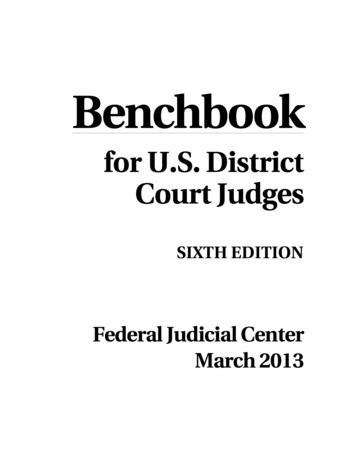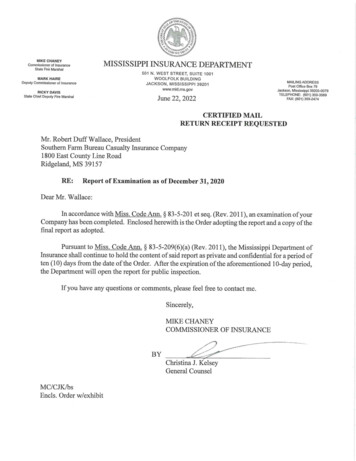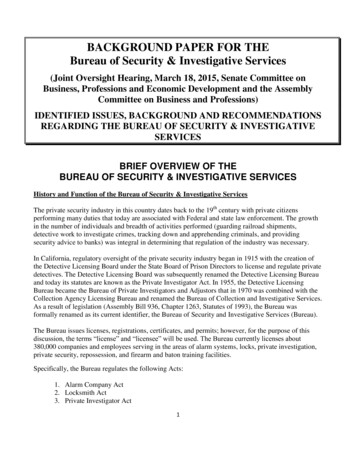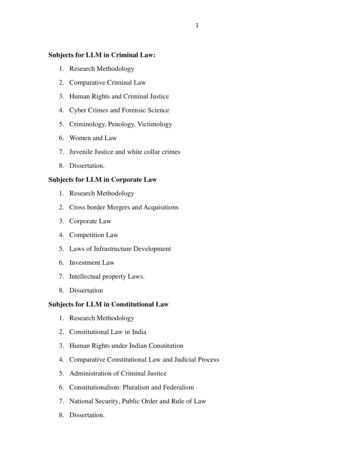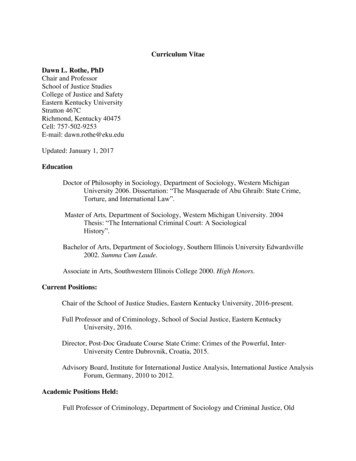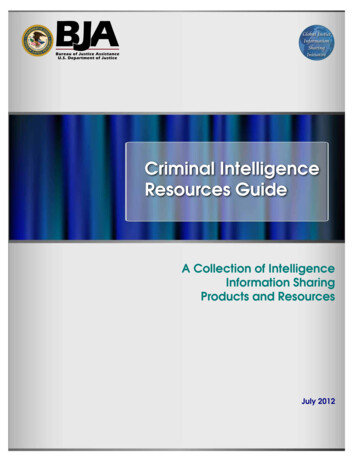
Transcription
Global JusticeInformationSharingInitiativeCriminal IntelligenceResources GuideA Collection of IntelligenceInformation SharingProducts and ResourcesJuly 2012
Criminal IntelligenceResources GuideTable of ContentsForeword. iiiHow to Use This Guide.1Intelligence Resources Request Form.2Analysts.5Fusion Centers.6Policy.6Training and Technical Assistance (specific to fusion centers).7Technology.8Gangs.9General Intelligence. 10Nationwide SAR Initiative (NSI). 12Privacy. 14Security. 16Training (other than fusion center training). 17Appendix A—Intelligence and InformationSharing Web Sites. 18About GlobalThe Global Justice Information Sharing Initiative (Global) serves as a FederalAdvisory Committee to the U.S. Attorney General on critical justice informationsharing initiatives. The Bureau of Justice Assistance (BJA) partners with Globaland its state, local, tribal, and federal representatives to promote standards-basedelectronic information exchange to provide justice and public safety communitieswith timely, accurate, complete, and accessible information in a secure and trustedenvironment.This project was supported by Grant No. 2009-DB-BX-K105 awarded by the Bureau of Justice Assistance, Office of Justice Programs,U.S. Department of Justice, in collaboration with the Global Justice Information Sharing Initiative. The opinions, findings, andiiconclusions or recommendations expressed in this publication are those of the author(s) and do not necessarily reflect the views of theU.S. Department of Justice.
Criminal IntelligenceResources GuideForewordThe Bureau of Justice Assistance (BJA) has supported the development of manyvaluable resources, based on the recommendations of the Global Justice InformationSharing Initiative (Global), its working groups, and partner agencies and organizations,that assist law enforcement intelligence personnel to improve agency operationsand criminal intelligence sharing efforts. To centrally locate these resources so as toprovide the law enforcement intelligence community with an informative referenceto “all things intelligence” is an ongoing challenge. As such, BJA has released theCriminal Intelligence Resources Guide to address this need.The Criminal Intelligence Resources Guide is not an all-encompassing guideto intelligence products; however, it does provide a valuable representation ofintelligence-related resources available to the intelligence community. This documentis considered to be a “living document,” and persistent effort will be employed tocontinually update it as new resources are identified. The effort of BJA, in partnershipwith Global, the CICC, and other state, local, tribal, and federal government officials,provides a well-balanced approach not only to the content and organization of thisdocument but also to the many resources detailed herein.About the Criminal Intelligence Coordinating CouncilThe Criminal Intelligence Coordinating Council (CICC) was created to providerecommendations and suggested actions regarding the development and sharing ofcriminal intelligence and information to BJA, through the Global Advisory Committee(GAC). The CICC was established in May 2004 and is made up of membersrepresenting law enforcement and homeland security agencies from all levels ofgovernment. It serves as an advocate for state, local, and tribal law enforcement andtheir efforts to develop and share criminal intelligence for the purpose of promotingpublic safety and securing the nation.The GAC supports BJA through acting as a focal point for justice information sharingactivities and works to provide the U.S. Attorney General and BJA with appropriateinput from state, local, tribal, and federal agencies/associations in the ongoing pursuitof interjurisdictional and multidisciplinary justice information sharing.Relationship to Intelligence-Led PolicingThe goals of the Criminal Intelligence Resources Guide and intelligence-led policing(ILP) are very similar, in that both ILP and the Criminal Intelligence ResourcesGuide seek to provide law enforcement with the ability to strategize and take atargeted approach to crime control while focusing on the identification, analysis, andmanagement of persisting and developing problems. ILP implementation results inbetter allocation of resources, saving money, crime prevention rather than reaction,and use of technology and well-defined business processes.iii
Criminal IntelligenceResources GuideivThe CICC believes that the Criminal Intelligence Resources Guide will be a valuableasset to law enforcement agencies that engage in ILP by providing them with a singledocument of well-organized products and resources that benefit the intelligencecommunity and the institutionalization of ILP.
Criminal IntelligenceResources GuideHow to Use This GuideThe Criminal Intelligence Resources Guide focuses on intelligence products availableto law enforcement officials. This guide contains a listing of available products and abrief summary of what each product entails.The guide is broken down into the following categories: Analysts Fusion Centers Policy Training and Technical Assistance (specific to fusion centers) Technology Gangs General Intelligence Nationwide SAR Initiative (NSI) Privacy Security Training (other than fusion center training)Documents are sorted alphabetically under each category and are availableelectronically via the hyperlinked title. To access a document electronically, click onthe title of the document or copy the Web address (underneath the document title) andthen paste it into your browser’s address bar. Hard copies may also be obtained bycompleting the order form (included on page vi) and submitting it online, by e-mail, orby fax.Access to Copies of ResourcesContained in This GuideElectronic Copy AccessFor an electronic copy of any of the resources detailed in this guide, please click onthe title of the document in which you are interested and you will be taken to the copyavailable online. You may print out as many copies as you need.Hard-Copy AccessFor hard copies of any of the resources detailed in this guide, please complete theenclosed form and e-mail it to information@ncirc.gov.1
Criminal IntelligenceResources GuideIntelligence ResourcesRequest FormDocument NameQuantity1.2.3.4.5.6.7.8.Shipping Information:—Name:Title:Address 1:Address 2:City, State, Zip:Phone Number:E-mail Address:Additional Shipping Notes:Send to:E-mail: information@ncirc.govFax: (850) 422-35292Mail: IIR/Information SharingPost Office Box 12729Tallahassee, FL 32317
—Criminal IntelligenceResources GuideANALYSTSAnalyst ToolboxCommon Competencies for State, Local, and Tribal Intelligence AnalystsLaw Enforcement Analyst Certification StandardsLaw Enforcement Analytic StandardsFUSION CENTERSBaseline Capabilities for State and Major Urban Area Fusion CentersCritical Infrastructure and Key Resources (CIKR): Protection Capabilities for Fusion CentersFire Service Integration for Fusion CentersHealth Security: Public Health and Medical Integration for Fusion CentersFusion Center Guidelines: Law Enforcement Intelligence, Public Safety, and the PrivateSectorFusion Center Guidelines Resource CDFusion Process Technical Assistance Program and ServicesDefining Fusion Center Technology Business Processes: A Tool for PlanningFusion Center Technology GuideFusion Center Technology Resources Road MapGANGSGuidelines for Establishing and Operating Gang Intelligence Units and Task ForcesGENERAL INTELLIGENCE10 Simple Steps to Help Your Agency Become a Part of the National Criminal IntelligenceSharing Planseepage 10Interagency Threat Assessment and Coordination Group (ITACG) Intelligence Guide for FirstRespondersseepage 10Law Enforcement Intelligence: A Guide for State, Local, and Tribal Law EnforcementAgencies, Second EditionNational Criminal Intelligence Sharing Plan—Full Report, Executive Summary, and CDNavigating Your Agency’s Path to Intelligence-Led PolicingWhy Law Enforcement Agencies Need an Analytical FunctionNATIONWIDE SAR INITIATIVE (NSI)Findings and Recommendations of the Suspicious Activity Report (SAR) Support andImplementation ProjectSuspicious Activity Reporting Process Implementation ChecklistSuspicious Activity Reporting Line Officer TrainingSuspicious Activity Reporting Private Sector Security TrainingSuspicious Activity Reporting Fire and Emergency Medical Services TrainingSuspicious Activity Reporting Probation, Parole, and Corrections TrainingSuspicious Activity Reporting Public Safety Telecommunications TrainingSuspicious Activity Reporting Emergency Managment TrainingPRIVACYFusion Center Privacy Policy Development: Privacy, Civil Rights, and Civil Liberties PolicyTemplateThe Importance of Privacy, Civil Rights, and Civil Liberties Protections in American LawEnforcement and Public Safety Training VideoPrivacy, Civil Rights, and Civil Liberties Compliance Verification for the Intelligence EnterpriseRecommendations for First Amendment-Protected Events for State and Local LawEnforcement AgenciesThe Role of State and Local Law Enforcement at First Amendment Events Reference Card(continued on page 4)3
Criminal IntelligenceResources GuideANALYSTSAnalyst ToolboxSECURITYseepage16Electronic Questionnaires for Investigations Processing (e-QIP)Personnel Security Frequently Asked QuestionsState & Local Clearance ProcessUser’s Responsibility Guide: Secure Terminal Equipment (STE); QSEC – 2700 SecureCellular PhoneTRAININGCommon Competencies for State, Local, and Tribal Intelligence AnalystsMinimum Criminal Intelligence Training Standards for Law Enforcement and Other CriminalJustice Agencies in the United States4
Criminal IntelligenceResources GuideAnalystsAnalyst Toolboxhttp://it.ojp.gov/docdownloader.aspx?ddid 1284Provides intelligence analysts with information on the tools theyneed to effectively and efficiently perform their duties and produceuseful intelligence products. The tools examined in this documentrepresent the basic toolbox that the intelligence analyst will needto provide the vital intelligence service expected in today’s lawenforcement environment.Common Competencies for State, Local,and Tribal Intelligence Analystshttp://it.ojp.gov/docdownloader.aspx?ddid 1296Identifies common analytic competencies that should beexhibited by state, local, and tribal intelligence analystsworking in state or major urban area fusion centers or similaranalytic law enforcement entities. These competencies areessential for analysts to effectively perform their job dutiesand are required in their unique operating environments.Law Enforcement Analyst law enforcement analystcertification standards.pdfConsists of 25 standards that explain the requirements of agenciesto adopt the minimum standards for intelligence-led policingin order to support the development of sound, professional,and analytical products (intelligence). Included are educationalstandards and intelligence process standards, as well astestimony, data-source attribution, and feedback standards.N T OFJTICEhttp://it.ojp.gov/documents/law enforcement analyticstandards.pdfETMUSLaw Enforcement Analytic StandardsDEPARAssists in instituting standards for the intelligence analysis processto ensure that intelligence products are accurate, timely, factual,and relevant, while also recommending implementation of policyand/or action(s). The certification standards incorporate the LawEnforcement Analytic Standards, developed by the InternationalAssociation of Law Enforcement Intelligence Analysts (IALEIA)with support from the Global Intelligence Working Group (GIWG).Global JusticeInformationSharingInitiativeUnited StatesDepartment of JusticeLawEnforcementAnalyticStandards2nd editionApril 20125
Criminal IntelligenceResources GuideFusion CentersPolicyBaseline Capabilities for State and MajorUrban Area Fusion Centershttp://it.ojp.gov/docdownloader.aspx?ddid 1051Identifies the baseline capabilities for fusion centers andthe operational standards necessary to achieve each of thecapabilities. It is an addendum to the U.S. Department ofJustice’s (DOJ) Global Justice Information Sharing Initiative’sFusion Center Guidelines, which provide guidance to ensurethat fusion centers are established and operated consistentlyacross the country. Using the Fusion Center Guidelines,as well as identified best practices, federal, state, and localofficials identified the capabilities and standards necessaryfor a fusion center to be considered capable of performingbasic functions.Critical Infrastructure and Key Resources(CIKR): Protection Capabilities for ddid 1136Identifies the capabilities necessary for fusion centers toestablish a critical infrastructure and key resources (CIKR)protection analytic capability that supports infrastructuresecurity activities at the state and local levels. It also providesguidance for those fusion centers that have chosen to support Critical InfrastructureProtection (CIP) activities; outlines the additional capabilities fusion centers shouldachieve in order to effectively integrate CIKR activities into their analysis andinformation/intelligence sharing processes; and identifies how centers should supportrisk-reduction efforts taken by federal, state, local, and private sector partners. Finally,this document provides the federal, state, local, and private sector officials responsiblefor protecting CIKR with an overview of the value in working with their local fusioncenters and how they can better integrate their CIP-related activities with the efforts ofthose fusion centers.Fire Service Integration for Fusion Centershttp://it.ojp.gov/docdownloader.aspx?ddid 12446Identifies recommended actions and guidance for state and major urban area fusioncenters (fusion centers) to effectively integrate the fire service into the fusion process.Within the context of this document, the fire service is defined as including fire
and emergency operations, emergency medical serviceoperations, rescue operations, hazardous materialsoperations, fire prevention/protection, fire investigation,incident management, and responder safety. The documentis an appendix to the U.S. Department of Justice’s (DOJ)Global Justice Information Sharing Initiative’s BaselineCapabilities for State and Major Urban Area Fusion Centers.Criminal IntelligenceResources GuideHealth Security: Public Health andMedical Integration for Fusion CentersThis document assists fusion centers as they integratepublic health and health care (PH/HC) community partnersinto their operations. This appendix to the BaselineCapabilities document identifies considerations for fusioncenters to effectively integrate the information, resources,personnel, and/or expertise of the PH/HC community intotheir existing analytic operations and information/intelligencesharing processes.Fusion Center Guidelines: LawEnforcement Intelligence, Public Safety,and the Private Sector**Also available online as a resource CDhttp://it.ojp.gov/documents/fusion centerguidelines.pdfDeveloped to ensure that fusion centers areestablished and operated consistently, resultingin enhanced coordination efforts, strengthenedpartnerships, and improved crime-fighting and antiterrorism capabilities. The guidelines and relatedmaterials will provide assistance to centers as theyprioritize and address threats posed in their specificjurisdictions for all crime types, including terrorism.ETMN T OFJTI sistance.pdfGlobal JusticeInformationSharingInitiativeUSFusion Process Technical Assistance Programand ServicesDEPARTraining and Technical AssistanceUnited StatesDepartment of JusticeDHS/DOJFusion ProcessTechnicalAssistanceProgramand ServicesTo facilitate the development of a national fusion center capability,the U.S. Department of Homeland Security’s (DHS) Protectionand National Preparedness and the U.S. Department of Justice’s(DOJ) Bureau of Justice Assistance partnered in 2007 to develop5the Fusion Process Technical Assistance Program. The FusionProcess Technical Assistance Program consists of the followingcomponents: fusion process technical assistance services, the Fusion CenterExchange Program, fusion center fellowship programs, online fusion processresources, and other specialized fusion process support services. Further, in an effortto accelerate the implementation of baseline capabilities within all state and urbanarea fusion centers, DHS and DOJ have partnered to develop 15 targeted fusionprocess technical assistance services found in this catalog.th EditionRevised September 20107
Criminal IntelligenceResources GuideTechnologyDefining Fusion Center Technology BusinessProcesses: A Tool for Planninghttp://it.ojp.gov/docdownloader.aspx?ddid 1118Provides a tool to fusion center directors/managers to assistwith understanding and implementing the fundamentalbusiness requirements of their centers and planning theunderlying components for each of the business processesa particular fusion center is or will be undertaking (e.g., SARprocess, training, statewide incident analysis). It is essentialthat each center fully define its business processes beforeattempting to purchase or develop technology to handle thoseprocesses. If processes are not clearly defined, the technologywill drive the business processes rather than the businessprocesses driving the technology.Fusion Center Technology Guidehttp://it.ojp.gov/docdownloader.aspx?ddid 1283Provides a methodology for fusion center directors andmanagers that can be used to facilitate technology planningand to provide a practical perspective on the value oftechnology as an enabler of the fusion center mission. Fusioncenter directors and managers can use the document to aidin the development and implementation of technology withintheir fusion centers to achieve their missions.Fusion Center Technology Resources RoadMaphttp://it.ojp.gov/documents/Fusion CenterResources Road Map.pdfProvides fusion center leaders—in particular, seniortechnology managers—with guidance on how information,technology infrastructure, applications, performance metrics,and business processes align with the core businesscapabilities of a fusion center. Leaders can use this documentto assist in formulating a strategic technology vision andplan for their centers and to support sound investment andtechnology selection decisions within such a plan.8
Criminal IntelligenceResources GuideGangsGuidelines for Establishing and OperatingGang Intelligence Units and Task Forceshttp://it.ojp.gov/docdownloader.aspx?ddid 1058Provides guidance to agencies seeking to establish andoperate gang task forces or gang intelligence units withintheir jurisdictions or to those agencies that participate ingang task forces. This document was developed by theGang Intelligence Strategy Committee (GISC), under theU.S. Department of Justice’s Global Justice InformationSharing Initiative’s Intelligence Working Group. TheGISC—composed of federal, state, local, and tribal lawenforcement; justice; and corrections representatives—istasked with improving gang-related information sharing.9
Criminal IntelligenceResources GuideGeneral IntelligenceWeb site: www.it.ojp.gov/globalProvides valuable guidance for systematically sharing lawenforcement information among federal, state, local, and tribal lawenforcement agencies—large or small—using ten succinct stepsto information sharing success.DEPARN T OFJTICEhttp://it.ojp.gov/documents/Ten Steps.pdf1.ETMUS10 Simple Steps to Help Your Agency Becomea Part of the National Criminal IntelligenceSharing Plan10SimpleStepsto help youragency becomea part of theNationalCriminalIntelligenceSharing PlanWorking towards2.3.Connect to your state criminal justice network and regionalintelligence databases, and participate in information sharinginitiatives4.Ensure privacy issues are protected in policy and practice5.Access law enforcement Web sites, subscribe to law enforcementlistservs, and use the Internet as an information resource6.Provide your agency members with appropriate training on thecriminal intelligence process7.Become a member of your in-region Regional InformationSharing Systems (RISS) centerMany states provide access to other government databases, including motor vehicles, corrections,and others. Regional intelligence databases and sharing initiatives promote communication andcollaboration by providing access to other agencies’ and organizations’ investigative and intelligencedata.Some training models or modules are already found in Internet-based and interactive CDs, such asthe International Association of Law Enforcement Intelligence Analysts (IALEIA), National White CollarCrime Center, and LEIU “Turn Key Intelligence.” A listing of available intelligence training sources andspecifically scheduled classes is found on the IALEIA Web site: www.ialeia.org. This listing allowsindividuals to directly contact training source agencies and organizations for more information onclasses and schedules.RISS operates the only secure Web-based nationwide network for communication and exchangeof criminal intelligence information by local, state, federal, and tribal participating law enforcementmember agencies. RISS partners with other law enforcement systems to electronically connect them toTMRISSNET , including High Intensity Drug Trafficking Areas (HIDTA) Investigative Support centers andother federal and state agency systems.8.Become a member of the Federal Bureau of Investigation’s (FBI)Law Enforcement Online (LEO) system9.Partner with public and private infrastructure sectorsThe FBI’s LEO system is a sensitive but unclassified, real-time information sharing communicationssystem for all levels of the law enforcement community and is available at no cost to its users. LEOprovides secure e-mail capability, a national alert mechanism, and access to over 125 special-interestgroups for sharing information by providing access to other networks, systems, databases, and otherservices.federal law enforcementagencies—large or smallReprinted 02/08The protection of individuals’ privacy and constitutional rights is an obligation of government officialsand is crucial to the long-term success of criminal intelligence sharing. The Plan provides guidelinesthat support policies which will protect privacy and constitutional rights while not hindering theintelligence process. Implementing and supporting privacy policies and practices within your agencywill also reduce your organization’s liability concerns.Many Web sites on the Internet and others on closed networks provide valuable intelligenceassessments and news. Listservs provide instant and widespread communication for investigators.Listservs allow both the receipt and distribution of intelligence information. The Internet provides awealth of open-source information, including government information and access to private agenciesthat share with law enforcement.law enforcementinformation amongEstablish a mission statement and a policy to address developingand sharing information and intelligence data within youragencyThe Plan provides model policies and guidelines for implementing or reviewing an agency’s intelligencefunction. Examples include Criminal Intelligence Systems Operating Policies federal regulation28 CFR Part 23, the International Association of Chiefs of Police’s Criminal Intelligence Model Policy,and the Law Enforcement Intelligence Unit’s (LEIU) Criminal Intelligence File Guidelines.systematically sharinglocal, state, tribal, andRecognize your responsibilities and lead by exampleRecognize the value of sharing intelligence information within your own agency, and encouragethe practice of sharing information with other law enforcement and public safety agencies. Use theguidelines and action steps outlined in the National Criminal Intelligence Sharing Plan (“Plan”) toimplement or enhance your organization’s intelligence function.Regular communication with the entities that control America’s critical infrastructures, such as energy,agriculture, transportation, and shipping, is critically important to ensuring the safety and security of thecitizens in your community.10. Participate in local, state, and national intelligence organizationsIn most areas of the country, there are locally based intelligence organizations that welcomeparticipation from all agencies and are often affiliated with state and national organizations.United StatesDepartment of JusticeTo request copies:Call: (202) 282-9683This document was prepared under the leadership, guidance, and funding of the Bureau of Justice Assistance (BJA),Office of Justice Programs, U.S. Department of Justice, in collaboration with the U.S. Department of Justice’s Global JusticeInformation Sharing Initiative. The opinions, findings, and conclusions or recommendations expressed in this document arethose of the authors and do not necessarily represent the official position or policies of the U.S. Department of Justice.Interagency Threat Assessment andCoordination Group (ITACG) IntelligenceGuide for First TACGGuide 2ed.pdfDesigned to assist state, local, and tribal law enforcementand firefighting, homeland security, and appropriate privatesector personnel in accessing and understanding federalcounterterrorism, homeland security, and weapons of massdestruction intelligence reporting. Most of the informationcontained in this guide was compiled, derived, and adapted fromexisting intelligence community and open source references.To request copies:Call: (800) 421-6770Web: cops.usdoj.govLaw Enforcement Intelligence: A Guide forState, Local, and Tribal Law EnforcementAgencies, Second Editionhttp://it.ojp.gov/docdownloader.aspx?ddid 113310Describes changes (since the publication of the first edition) in thephilosophy, national standards, and practice of law enforcementintelligence, while maintaining the core goal of being a primer on“all things intelligence” for the law enforcement community. Theguide is intended to support policy in law enforcement agenciesand seeks to objectively provide the best knowledge and practiceof law enforcement intelligence at the time of publication. It is not intended to be anacademic work, nor does it look at theoretical issues or arguments. It is not directedas a guide to the intelligence community except to explain the roles, responsibilities,and restrictions of the intelligence community’s state, local, and tribal law enforcementpartners.
National Criminal IntelligenceSharing Plan (NCISP)Criminal IntelligenceResources GuideUnited StatesDepartment of Justicehttp://it.ojp.gov/documents/NCISP Plan.pdf“I am pleased to announce that I have just approvedthe National Intelligence Sharing Plan, a direct resultof recommendations made at the IACP Summit heldin March of 2002. With the Plan formally in place, wecan build on the communication, coordination, andcooperation that are winning the fight against crimeand the war against terror.”**Also available online as an overview CD(http://it.ojp.gov/documents/ncisp/)John AshcroftFormer U.S. Attorney General“Critical to preventing future terrorist attacks isimproving our intelligence capability. The Plan willserve as a blueprint as we continue to develop ouroverall national strategy for sharing information.”Robert MuellerDirector, Federal Bureau of Investigation**Also available – Executive Summary(http://it.ojp.gov/documents/NCISPexecutive summary.pdf)Executive SummaryNational CriminalIntelligence Sharing Plan“.We must create new ways to share information andintelligence both vertically, between governments, andhorizontally, across agencies and jurisdictions.effortswith the Global Intelligence Working Group to create ahe need for a National Criminal Intelligence Sharing Plan (“Plan”) wasNational Criminal Intelligence Sharing Plan.a helpfulrecognized as critical after the tragic events of September 11, 2001, whenand welcome response.”nearly 3,000 innocent lives were lost as a result of terrorist attacks against theTom RidgeUnited States. This event initiated a concerted effort by American law enforcementFormer Secretary, U.S. Departmentof to correct the inadequacies and barriers that impede information andagenciesHomeland Securityintelligence sharing—so that future tragedies could be prevented.In spring 2002, law enforcement executives and intelligence experts attending theThirdPrintingAssociation07/05Internationalof Chiefs of Police (IACP) Criminal Intelligence SharingSummit recognized that local, state, tribal, and federal law enforcement agenciesand the organizations that represent them must work towards common goals—gathering information and producing intelligence within their agency and sharin
Criminal Intelligence Resources Guide to address this need. The Criminal Intelligence Resources Guide is not an all-encompassing guide to intelligence products; however, it does provide a valuable representation of intelligence-related resources available to the intelligence community. This document


